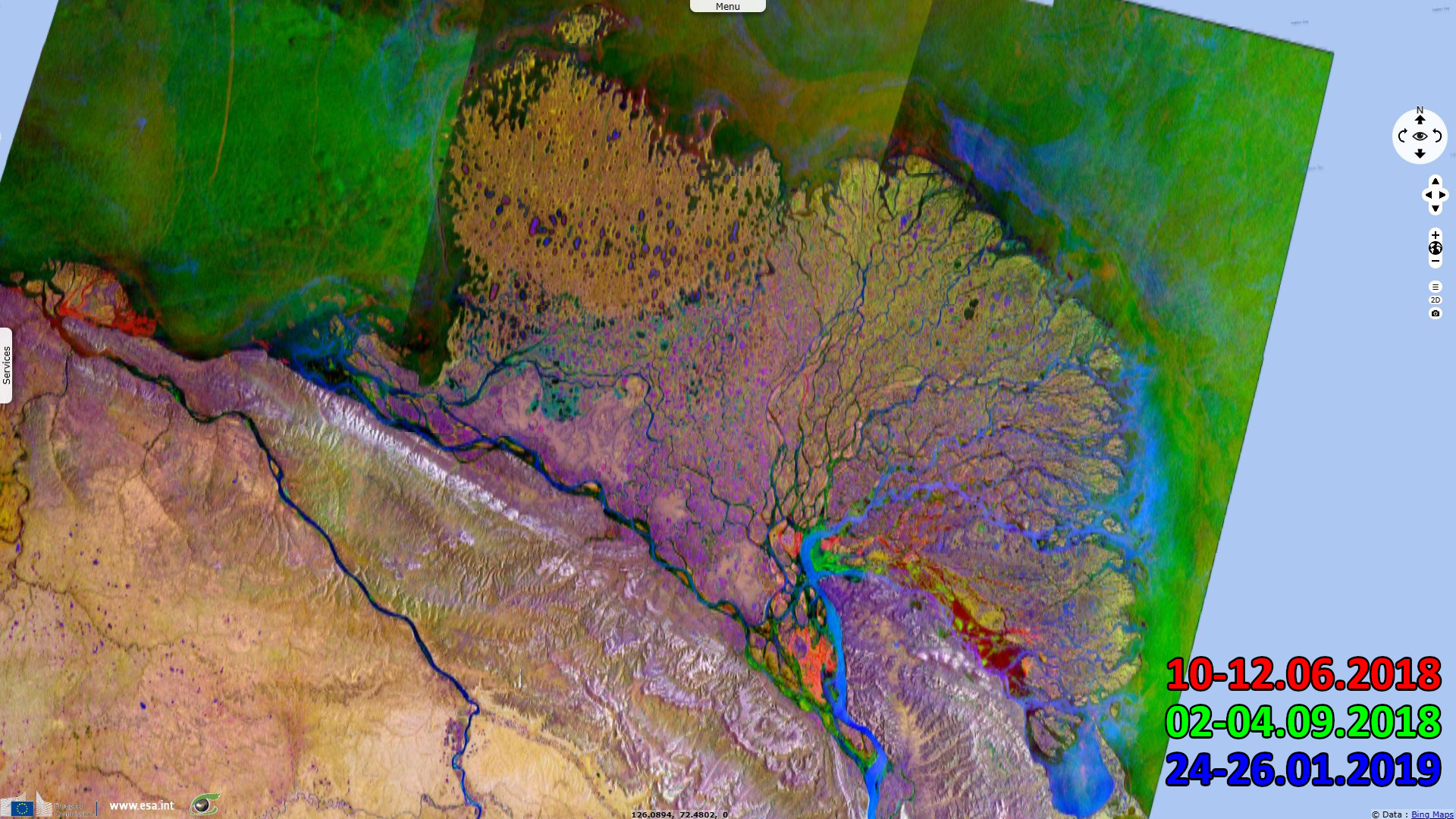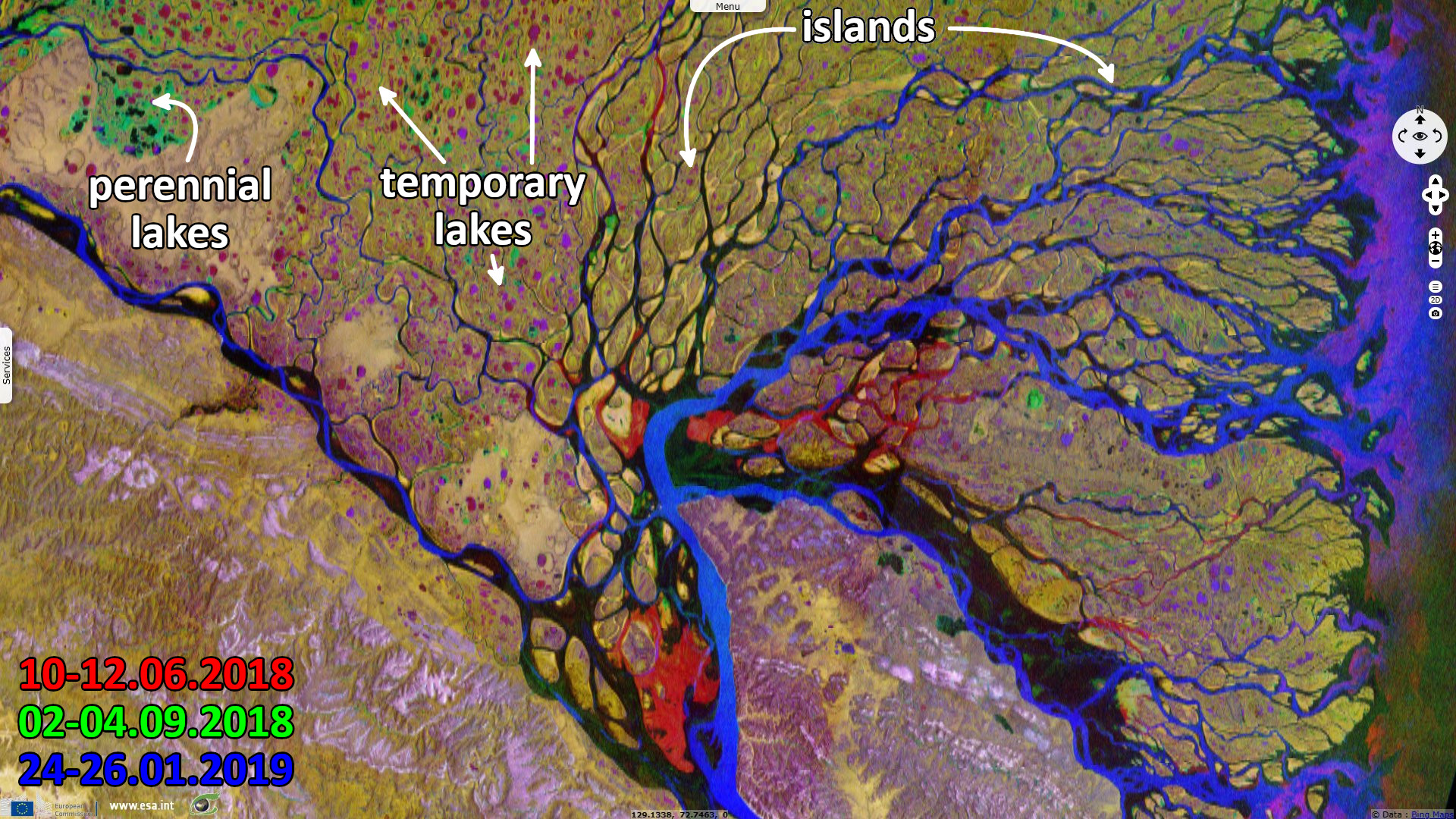Changing colours & biodiversity of the Lena river delta, Russia
Sentinel-2 MSI acquired on 02 September 2016 at 03:45:32 UTC
Sentinel-2 MSI acquired on 10 June 2018 at 04:05:41 UTC
Sentinel-1 CSAR IW acquired on 10 June 2018 from 22:35:20 to 22:35:49 UTC
Sentinel-1 CSAR IW acquired on 02 September 2018 from 22:35:25 to 22:35:54 UTC
Sentinel-1 CSAR IW acquired on 24 January 2019 from 22:35:23 to 22:35:52 UTC
Sentinel-2 MSI acquired on 10 June 2018 at 04:05:41 UTC
Sentinel-1 CSAR IW acquired on 10 June 2018 from 22:35:20 to 22:35:49 UTC
Sentinel-1 CSAR IW acquired on 02 September 2018 from 22:35:25 to 22:35:54 UTC
Sentinel-1 CSAR IW acquired on 24 January 2019 from 22:35:23 to 22:35:52 UTC
Keyword(s): Coastal, polar, arctic, river, delta, sea ice, pack ice, hydrology, biodiversity, natural reserve, Siberia, Russia, Arctic Ocean
"Siberia's Lena River is one of the longest rivers in the world.", resituates the World Wide Fund for Nature (WWF). The delta of the Lena River is located in the Sakha Republic, in the far north of eastern Siberia, Russia. It is the easternmost of the three great Siberian rivers that flow into the Arctic Ocean (the other two being the Ob and the Yenisey). "It rises west of Lake Baikal eventually flows north for 4400 km before emptying into the Laptev Sea, an arm of the Arctic Ocean."
Along its course lie forests, meadows, valleys, and rocky hills. Permafrost underlies most of the catchment, 77% of which is continuous. It is 4294 km long, and has a drainage basin of 2 490 000 km² (bigger than Algeria).
"Just before pouring into the Laptev Sea, the Lena splits into several small rivers that flow through a flat plain to create the Lena River Delta.", adds the WWF in another article. "The river forms a huge delta of 32 000 km², which is the largest Arctic delta and the most extensive protected wilderness area in Russia.". No other river in the Arctic Eurasia forms such a large delta.
The Natural Heritage Protection Fund reminds a specificity of the location of the Lena delta: "Geologic conditions of the delta and its relief are very peculiar. It is located near the edge of two giant lithosphere crustal plates - Eurasian and American. Here are found rocks of very diverse age - from the most ancient Paleozoic till relatively young Quarternary. Permafrost reaches the depth of 600 m. Thermokarst hollows and boolgoonyakhs are rather typical. Blanket sands are met everywhere and sandy spits are more rare."
"Each year the full-flowing Lena alluviales about 15 million tons of drift to its mouth forming here, by the Laptev Sea, the unique landscape, the global phenomena, - 6500 km of large and small branches, 30 000 lakes of different size and over 1500 islands and aits."
Regarding the biome, a third article of the WWF describes the area: "The region offers nearly every main type of arctic landscape. Typical northern tundra is found in the northwest of the delta, while to the southwest and the southeast are islands with their own specific landscape. The foothills of the Kharaulahsky mountain range and Chekanovsky chain of hills form complex mountain terrain."
There are numerous bodies of water, river branches and a nearby estuary zone. The Natural Heritage Protection Fund complements: "This boundless water mosaic is redoubled by the outstanding brightness of vegetation cover. The arctic tundra types presented here are very diverse: grassy, grassy-shrub, lichen-green moss and also the typical polygonal bogged tundra occupying small shallow depressions and bringing the landscape a special color."
This arctic ecoregion experiences seven months of winter before the snow-covered frozen tundra transforms into fertile wetlands. The flora and fauna in the delta is particularly rich and varied. "The flora list of the Ust-Lensky Reserve which occupies a significant part of the delta (14 330 km²) counts about 420 vascular plants species, 160 moss species, 70 lichen species and about 320 algae species. Such floristic diversity perceptibly outlines the delta from the neighboring areas of Yakutia." These species allow research into geobotanical, ecological and ecological-biochemical aspects.
The Lena River Delta is a haven for numerous species of birds, fish, and other animals. For the former, the WWF states: "The Lena River Delta is also a main nesting habitat for migratory birds. The intercontinental ties, flight paths and distances flown by delta birds is quite likely unique in the Arctic."
In total the area counts over 100 bird species major part of which is nesting here. The rarest species are the Siberian white crane and the cuneate-tailed gull. Others include "divers, ducks, plovers, sandpipers, snipes, phalaropes, terns, skuas, birds of prey and passerines are just some of the migratory birds that breed in the productive wetland." "The study of birds such as Bewick’s Swan, Black Brant, the Snow Goose, Common and Steller’s Elders, Sabine’s and Ross’ Gulls and Peregrine Falcon is of particular interest and value to the type of research undertaken by the IBS Lena-Nordenskjold."
"The wet tundra in the delta, which floods each spring, is an important area for nesting and migrating birds, and also supports a rich fish population. There are 92 planktonic species, 57 benthic species, and 38 species of fish in the river."
"Species found in the delta include the tugun, sardine, peled, and muksun ciscos, as well as broad whitefish. Spawning fish reported from the delta include Arctic lamprey and burbot."
Mammals range from tundra, mountain and northern-boreal species. The Natural Heritage Protection Fund lists some of the most important of them: "In the delta area one can find marine mammals like white whale, narwhal, three seal species and also the laptev walrus (the disappearing subspecie). Concerning the terrestrial mammals (about 30 species) of special notice are polar bear, wild reindeer, bighorn sheep, Kamchatka marmot, Arctic fox and lemming."
"Caribou and Arctic fox are the most important species from the viewpoint of those Indigenous peoples who rely on them for their own consumption.", supplements the WWF.
"The Lena Delta Reserve was expanded in 1995, making it the largest protected area in Russia (61 000 km²). "The Lena mouth forms the most favorable conditions for wintering, fattening and spawning shoals formation of valuable industrial fish species - nelma, muksun, Siberian and Arctic cisco and many others." writes the Natural Heritage Protection Fund.
It does not go without concerns, voiced by the WWF: "Overfishing, particularly of cisco populations is a concern. Outside of the reserve, mining, forestry, grazing, expanding agricultural activities, water diversion for irrigation, and pollution from fertilizers and pesticides may threaten the water quality and quantity that reaches the delta."











